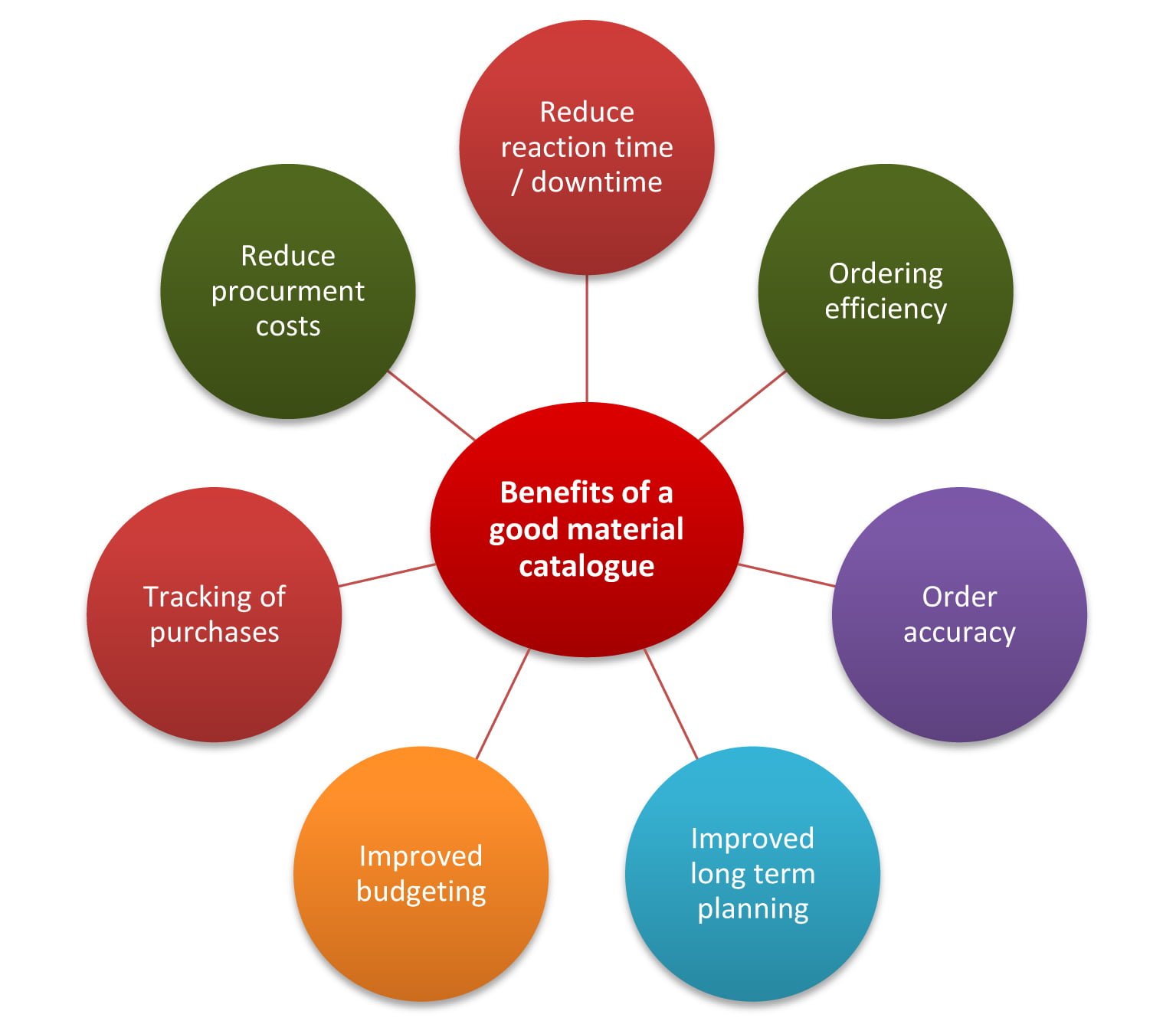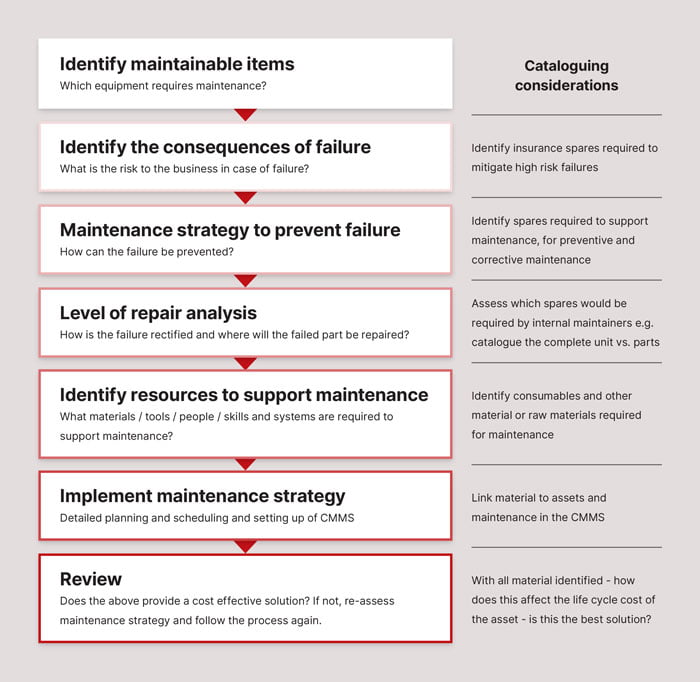To do maintenance effectively, we need to make sure we have the right quantities of the right spare parts and materials in the right place at the right time. To do this effectively, we need complete and accurate data about our equipment and their associated spare parts and materials. This information is generally stored in a Material Catalogue (or Material Master).
What is a materials catalogue?
A materials catalogue is a complete list of spare parts and materials required to meet the operational and maintenance requirements of the business. These items include:
- Spare parts (Rotables)
- Raw materials
- General consumables
The catalogue is usually indexed by a “Material Number” and captures all data required to uniquely identify the material to ensure the correct material is ordered and the material is correctly managed through its lifecycle. This could include the following data fields:
| Material number* | Material description* | Manufacturer name* |
| Manufacturers part number* | Supplier / vendor name | Supplier / vendor material number |
| Material long description* | Unit price* | Unit of measurement (UOM)* |
| Delivery lead time | Shelf life | Creation date |
| Material status (eg. active, superceded) | Colloquial names | Dimensions |
| Weight |
Together with the asset register, the materials catalogue forms the foundation of inventory, purchasing and maintenance management processes and systems. The quality of the catalogue has a direct impact upon these processes and systems as they contribute to the achievement of organisational goals.
During a recent supply audit that we conducted at a gold processing facility, we noted that 1480 non-stock direct purchases were made over a 12 month period, with a total purchase value of around $16.3m. What are the risks associated with this if the technical specifications for these items had not been clearly specified? Or worse, were incorrectly specified and not aligned with the original design intent for the equipment? What is the cost of the lost opportunity that may have been able to be realised if these parts were able to be included in a supply agreement with a recognised supplier, with resulting reductions in parts costs and potential improvements in supplier service level?
In addition, we found that a large number of identical spares had been separately catalogued, creating considerable duplication. What is the potential value of additional, unnecessary stock that is purchased and the cash tied up as a result? And what are the additional risks associated with obsolescence and deterioration over time??
At another client site, during a maintenance and reliability review, there were a significant number of overdue maintenance work orders sitting in backlog while waiting on spares parts. On further investigation, most of these spares parts were not catalogued and were procured via direct purchase orders. What is the cost of delaying maintenance due to parts not being available? What are the risks to plant integrity and safety? What is the potential impact on production?
Obviously, there are many benefits associated with a good standardised materials catalogue. The figure below illustrates some of these key benefits.

It should be possible to develop a sound business case for a good material catalogue. Some of the above benefits (such as holding costs and procurement costs) are easily quantified; others (such as the effort spent locating the correct item or the time wasted by a fitter doing emergency modifications) are more difficult to quantify, but real never the less.
The process for creating a catalogue
Cataloguing is the process of establishing, maintaining and managing materials data within a company’s Enterprise Resource Planning (ERP) system. A good cataloguing process ensures:
All required materials to support maintenance and operation is captured
Efficient and effective processing of cataloguing requests
Correct identification and classification of materials
Effective and efficient management of change to material data
Responsibilities are clearly stated and pursued
The figure below illustrates a good practice material catalogue management process.

Let’s now discuss these steps in detail.
Identify material for cataloguing
This is the step where we decide which parts are going to be required to support maintenance and should therefore be catalogued. This step is the most important step in the whole cataloguing process. Most organisations do this poorly and suffer consequences of not having catalogued the part or of having incorrectly identified the part.
What material to catalogue should be considered in conjunction with the preventive maintenance programme for the asset in question. The diagram below shows how the material and cataloguing considerations are linked to the preventive maintenance strategy for each asset.

The above process will identify what materials should be catalogued. Typically, these materials can be categorised as below:
| Material category | Usage predictability | Usage frequency | Risk addressed |
|---|---|---|---|
| Critical / insurance spares | Unpredictable | Low | Prevent major downtime |
| Parts required for ‘run to fail’ equipment (long lead time / significant risk) | Unpredictable | Low | Quick reaction to failures |
| Parts used for maintenance arising from condition monitoring | Somewhat predictable | Significant | Intervene before failure |
| Parts used on periodic replacements | Predictable | High | Order accuracy, shutdown success |
| Parts required for ‘run to fail’ equipment (low risk) | Unpredictable | Low | Quick reaction to failures |
It is important to ensure all the above categories have been considered when developing the asset maintenance strategy.
Submit request, review and catalogue item
Once we have identified material for cataloguing, the next step is to submit a request for cataloguing. This is usually done through an internal form that captures the mandatory data as described in the “What is a Material Catalogue?” section. It is important that all the unique attributes of the parts be identified to prevent the wrong part being ordered.
The request is usually reviewed and approved by an internal “Materials Management” function who ensures that the supplied information conforms to quality requirements, that the item is not already catalogued and that all naming and numbering conventions are correctly followed.
In our experience of working with clients from various industry sectors, the common issue with cataloguing items is a lack of standardisation of the essential material data. Catalogue coding standards can provide support to avoid this issue.
Catalogue coding standards
The material descriptive and classification data from the suppliers can be variable, non-standard and sometimes minimal. Consequently this data needs to be manipulated and improved in accordance with a standard/convention.
There are numerous standards and conventions available, with the most common being NATO/NSN, Oniqua Standards Dictionary, ECCMA(eOTD) and UNSPSC. It is important that your organisation either defines its own naming convention or follows one of the national or international standards.
Maintaining the materials catalogue
Last but not least in the cataloguing processes is maintaining the catalogue. It is essential to keep the catalogue up to date as materials and suppliers change. It is also essential to ensure that data quality does not erode over time. We recommend doing the following:
- Incorporate change of essential material data as a result of obsolescence, change of supplier, replacement of existing material, design change or addition of a new item in your change management process.
- Assign clear responsibilities for addition, deletion, updates of the materials in the catalogue.
- Conduct frequent audits of the material catalogue and the cataloguing process.
Conclusion
The key to cataloguing is in correctly and uniquely identifying the right materials required to support maintenance and operations.
Good quality material catalogues deliver bottom-line benefits throughout the organisation. A good material catalogue makes maintenance more efficient and minimises unplanned downtime. Not only does a good quality material catalogue assist in communication but it can help prevent unnecessary expense through the selection of incorrect materials, expediting, excessive stock holdings and rework.
As for deciding how much material to keep in stock… well, that may be a topic for another article.
I hope that this article has served as a useful resource in assessing how good your materials catalogue and cataloguing process is. In case you require assistance with cataloguing, spare parts optimisation, development parts list and bills of materials, or any other supply management consulting service, please contact one of our experienced consultants.
If you feel that you need help optimising your material catalogue, call us and talk to one of our expert consultants or email us today.
Subscribe to our newsletter here to receive future useful articles.
